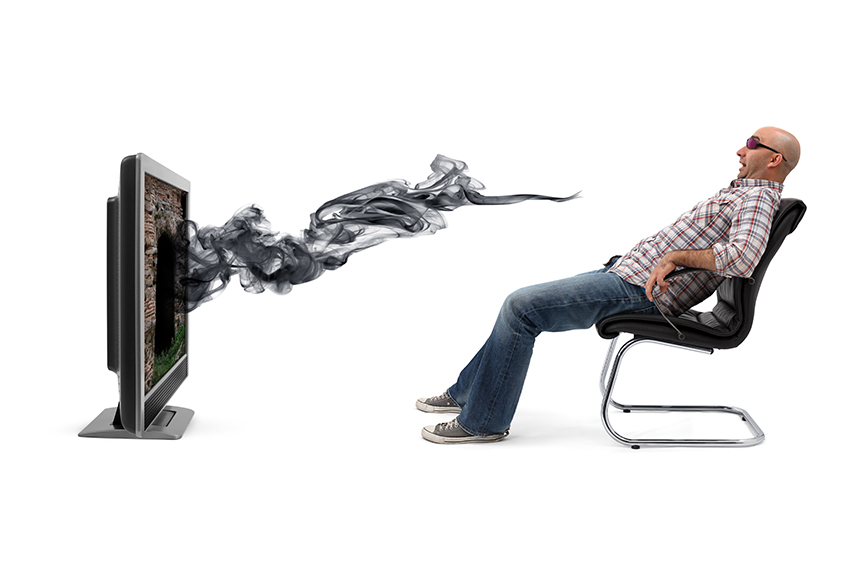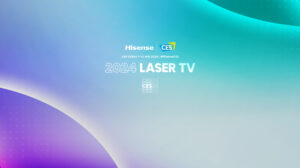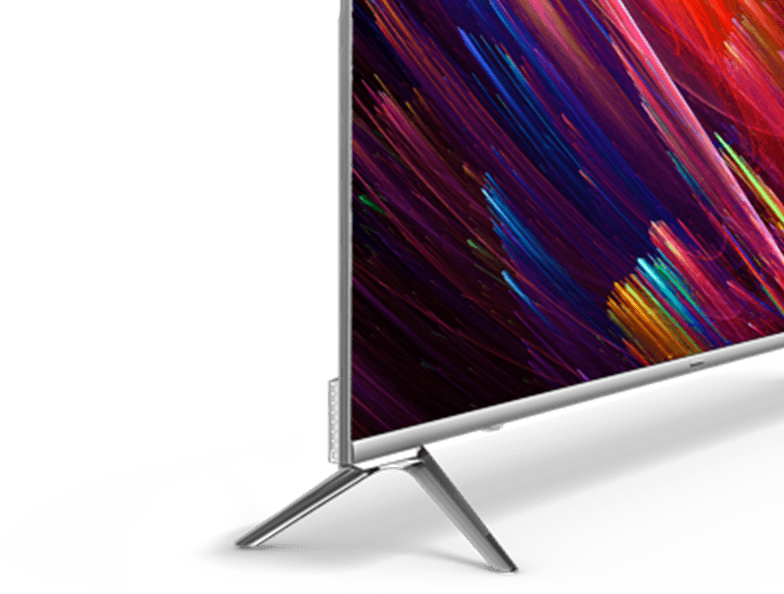Despite living in an age where we are always connected and entertainment can be accessed via our mobiles, computers or tablet devices, our in-home TV sets remain king.
Television is part of our life. A huge part. Every month we spend around 85 hours watching TV – on our TV sets. In fact around 90 percent of us still prefer to watch the box on the original box, not on our phones or tablets.
How did we get to this point? How did the TV become one of the most innovative consumer technologies and a powerhouse of the entertainment realm?

The beginning
The battle for supremacy at the beginning of the life of TV — at the end of the 19th century — was divided into those rallying for a mechanical television system verses the electronic television system.
Mechanical TV
German university student Paul Nipkow’s Nipkow disk was the foundation of the mechanical television system. Nipkow’s system of capturing light through holes in a disk led to a television discovery still in use today, the scanning principle. This principle describes the process in which light intensifies small portions of an image (lines or pixels) at any given time, before repeating the process. Today, this principle is called the ‘refresh rate’.
Electronic TV
Those that favoured the electronic television system were advocating cathode ray tube technology, this is the picture tube found in the TV sets we grew up with. German scientist Karl Braun invented the cathode ray tube (CRT) in 1897.
In CRT sets, the ‘cathode’ consists of a heated filament inside a vacuum tube made of glass. The ‘ray’ is a stream of electrons that reacts with the phosphor-coated screen on contact, changing its colour properties, thus producing images.
So who won? The electronic team. CRTs became the basis for TV as we know it.
Our first glimpse at TV
In the 1920s, John Logie Baird patented the idea of using arrays of transparent rods to transmit images for television. Baird’s 30-line images were the first demonstrations of television by reflected light rather than backlit silhouettes.
John Logie Baird explains his very first TV model.
The first working prototype of a TV saw the light of day in 1927. Philo Farnsworth, only 21, showcased the CRT technology to display an image consisting of 60 horizontal lines. He filed for his first television patent that year, and by 1928 had transmitted the first live human images.
In 1929, Russian inventor Vladimir Zworykin improved upon existing CRT technology and demonstrated the first television system with the similar features to a modern TV.
These advances were all well and good but the problem was even if you had purchased a TV very early on – there wasn’t much to watch. Sales of TVs did not take off in the US until 1939 when US President Franklin D. Roosevelt delivered a recorded televised speech at the opening ceremony of the 1939 New York World’s Fair and baseball began broadcasting.
Early TV was simplistic – one camera was used and the picture quality was atrocious. In 1955, the first Australian television licences were issued in Sydney and Melbourne, and it was TCN-9 Sydney (now Channel 9) that achieved the historic first broadcast, “Good evening, and welcome to television,” presented by Bruce Gyngell, at 7pm on September 16th, 1956.
This iconic moment captured the attention of all Australian’s.
The government-owned Australian Broadcasting Commission (ABC) also expanded its radio broadcasting activities to include television broadcasting in Sydney and Melbourne on November 5th, 1956.
The ABC made its debut on TV in 1956.
By the end of that same year, HSV7 (Channel 7) Melbourne also began test transmissions
During the early days of Australian television, most of the programming consisted of established radio shows, such as Bob Dyer’s Pick-a-box. For the most part they were simply a broadcast of the radio transmission.
But the audience was breathtakingly small. By the end of 1956, it is estimated that only 1 percent of Sydney residents and 5 percent of Melbourne residents owned a television set, which cost about six to ten weeks’ pay for the average worker of the time.
Bringing colour into our world
Until 1953, households that owned a TV were limited to black-and-white pictures. Colour technology was actually available in the early 1940s, but due to the ban on the production of television sets and radio equipment (for consumers) by the US War Production Board from 1942 to 1945, opportunities for further testing and development were halted.
Colour television was introduced in Australia in 1975. The main networks celebrated with their own slogans – Come to Colour (ABC TV), Seven Colors Your World (Seven Network), Living Color and 0 – First in Color (0-10 Network).
Channel 9 celebrated its switch from black and white to colour with this new logo.
The widespread adoption of colour TV set the scene for further technology improvements for the humble TV. Tube TVs — CRTs — ceded their crown with the dominance of LCD sets about 10 years ago. Consumers love of big screens killed off CRT TVs. Of course LCD TVs have had their day, too. Recent evolutions have included flat screen TV, smart TV, HDTV, LCD, Plasma and OLED TV.
The LCD generation
A typical LCD screen is a rear projection unit that uses CCFL backlight. Big in its heyday, LCD TVs are now all but dead.
This is because LCD technology had some significant limitations. One of the most notable is the expense of producing larger (40-inch and above) models.
Additionally, the picture quality diminishes when viewed at an angle and there were significant problems with response time when it came to refreshing images, which led to a lag when reproducing fast-moving images. As a result, LCD TVs were always viewed as a rather bad choice for gaming or sports.
Plasma hype
Donald Bitzer, Gene Slottow, and Robert Willson invented the very first prototype for a plasma display monitor in 1964. Offering extremely wide viewing angles, relatively low prices, and the ability to produce amazing contrast ratios, plasma TVs were on top of the world for about a decade.
While popular, plasma wasn’t free from issues. The most notable of these was the power requirement that led to real problems with heat production, efficiency and a shorter lifespan than other technologies.
2014 essentially saw the death of the plasma TV. Not a single major manufacturer added a plasma display to their line-up after 2015.
LED – a gain in power efficiency
An LED TV uses the same fundamental technology as a typical LCD screen with the only major difference being in the way it’s backlit. While a typical LCD screen uses a cold cathode fluorescent light (CCFL) in order to produce bright and vivid colour, the LED (or LED-backlit LCD display) uses light emitting diodes (LEDs) to provide the backlight.
The benefit in the technology switch is mainly in power consumption — LED backlighting is 20 to 30 percent more efficient than CCFL.
3D – the passive and the active
While John Logie Baird showed off the first 3D TV in 1928 (yes 1928!) it was around 2010 when modern 3D TVs started entering the home, peaking just two years later.
Two different technologies actually vied for your attention: ‘passive 3D’ uses polarisation techniques to create the 3D image, while ‘active 3D’ uses powered glasses to get that extra depth.
Some active 3D TVs used the technology in a very clever way for normal 2D watching: by syncing two sets of glasses in the right way, you could actually have people watching two entirely different images on the same screen. Of course, you then had to argue over who got the sound!
3D TV is an interesting technology.
Smart TV
Smart TV, with its apps, widgets and features is undeniably cool. Smart TV currently dominates the market, so the only decision you’re really left with is which interface you prefer.
Here and now, and what’s coming
So that’s where we are today, but where are we going with TV technology? The next wave of TVs will be defined by resolution.
From standard-definition (480i), to enhanced definition (480p and 576p), high definition (720p, 1080i and 1080p) and now 4K (2160p), resolution improvements have come a long way.
TV resolution is measured using an ‘i’ for interlaced, or a ‘p’ for progressive. Interlacing takes advantage of the fact that our eyes can’t pick up information as fast as it’s displayed. If you think of a television screen as a series of lines numbered 1 through 100, interlaced technology splits the lines into evens and odds. First the television will produce an image on the even-numbered lines, and then 1/60th of a second later it will produce an image on the odd-numbered lines.
Progressive scan technology draws all of the lines simultaneously. This is the current standard that modern televisions use to measure resolution.
Unbelievable clarity with 4K
About a decade ago, manufacturers started to sell what’s now widely known as HDTV. These advanced televisions boasted resolutions of 1280×720 or even 1920×1080, with picture clarity far beyond what was previously possible. These high-resolution sets made major progress in colour accuracy and contrast.
But now HD is old news, there is another new technology — Ultra HD, also known as 4K HD. This new format, which offers a resolution of 3840×2160, has so far been reserved to super-high-end TVs.
The Hisense 4K ULED TVs have received rave reviews from Australia’s top tech journalists.
4K sets contain almost four times as many pixels as the best HD television. Large displays benefit greatly from 4K because the improved resolution can display a sharp image at a viewing distance of 10 feet even on displays over 120 inches.
If you’re looking to future-proof your home theatre, it’s probably not a bad decision to go 4K.
8k – The Future
The first broadcast using 8K TV technology occurred during the Rio Olympics. Japan’s public channel NHK used special cameras during the Olympics to broadcast part of the games in ‘Super Hi-Vision’. With a resolution of 7680 x 4320, 8K has four times the details of a 4K broadcast.
A study by Juniper Research predicts that 8K resolution, which delivers over 33,000,000 pixels, will be widespread by 2020.
Read more information on the latest Hisense 4K ULED TV here.









 Australia
Australia












